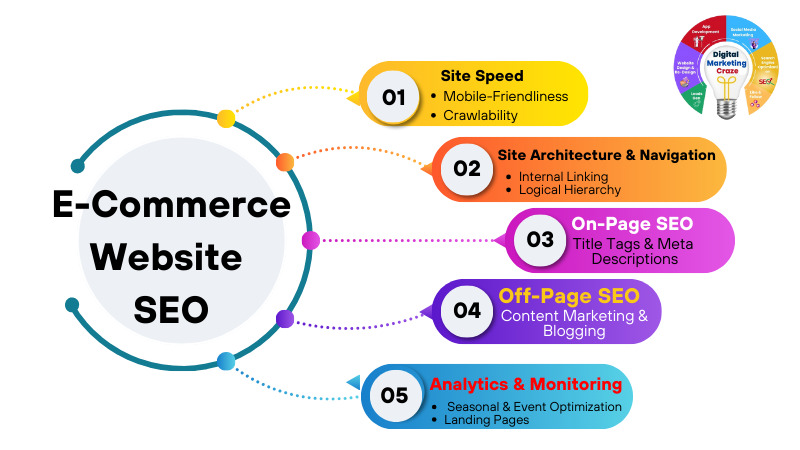E-Commerce Website SEO
Refers to the process of optimizing online stores to improve their visibility in search engine results for product-related queries. Unlike Local SEO (which focuses on geographic targeting), E-Commerce SEO aims to drive organic traffic, boost product discoverability, and increase sales by aligning with search intent for shoppers. Here is a detailed breakdown

Key Components of E-Commerce SEO
Keyword Research for Products
- Identify high-intent keywords (e.g., “buy running shoes online,” “organic skincare products”) using tools like Ahrefs, SEMrush, or Google Keyword Planner.
- Focus on long-tail keywords (e.g., “women’s waterproof hiking boots size 7”) to target niche audiences.
On-Page Optimization
Product Pages
Optimize titles, meta descriptions, headers (H1/H2), and URLs with relevant keywords.
Product Descriptions
Write unique, detailed and user-focused content (avoid duplicate manufacturer descriptions)
Image Optimization
Use descriptive filenames, alt text (e.g., "red-leather-handbag-women"), and compress images for faster loading.
Technical SEO
Structured Data (Schema Markup)
Implement product schema to enhance rich snippets (e.g., price, availability, reviews).
Site Speed
Optimize load times via tools like Google Page Speed Insights (critical for mobile users)
Mobile-Friendliness
Ensure responsive design and smooth mobile navigation.
Canonical Tags
Prevent duplicate content issues from product variants (e.g., colors/sizes).
XML Sitemap
Submit to Google Search Console to ensure all pages are crawled.
Content Marketing
Buyer Guides
Educate shoppers (e.g., "How to Choose the Best Running Shoes").
Blogs/Guides
Create content targeting informational queries (e.g., "how to style a leather handbag").
User-Generated Content
Encourage customer reviews and testimonials (boosts trust + SEO).
Internal Linking
- Link related products and categories (e.g., link “men’s sneakers” to “men’s athletic socks”).
- Use anchor text like “Shop Women’s Winter Coats” to guide users and search engines.
Category Page Optimization
- Optimize category titles/descriptions (e.g., “Affordable Women’s Dresses | [Brand Name]”).
- Add introductory content to category pages to improve relevance.
Unique Challenges in E-Commerce SEO
- Duplicate Content: Product variants (e.g., sizes/colors) or copied manufacturer descriptions.
- Thin Content: Pages with minimal text (e.g., product pages lacking descriptions).
- Crawl Budget Issues: Large sites with thousands of pages may struggle to get indexed.
- Competition: Competing with giants like Amazon or Walmart for rankings.
Backlink Strategy
- Earn links from niche blogs, influencers, or product review sites.
- Collaborate with affiliates or partners for branded mentions.
